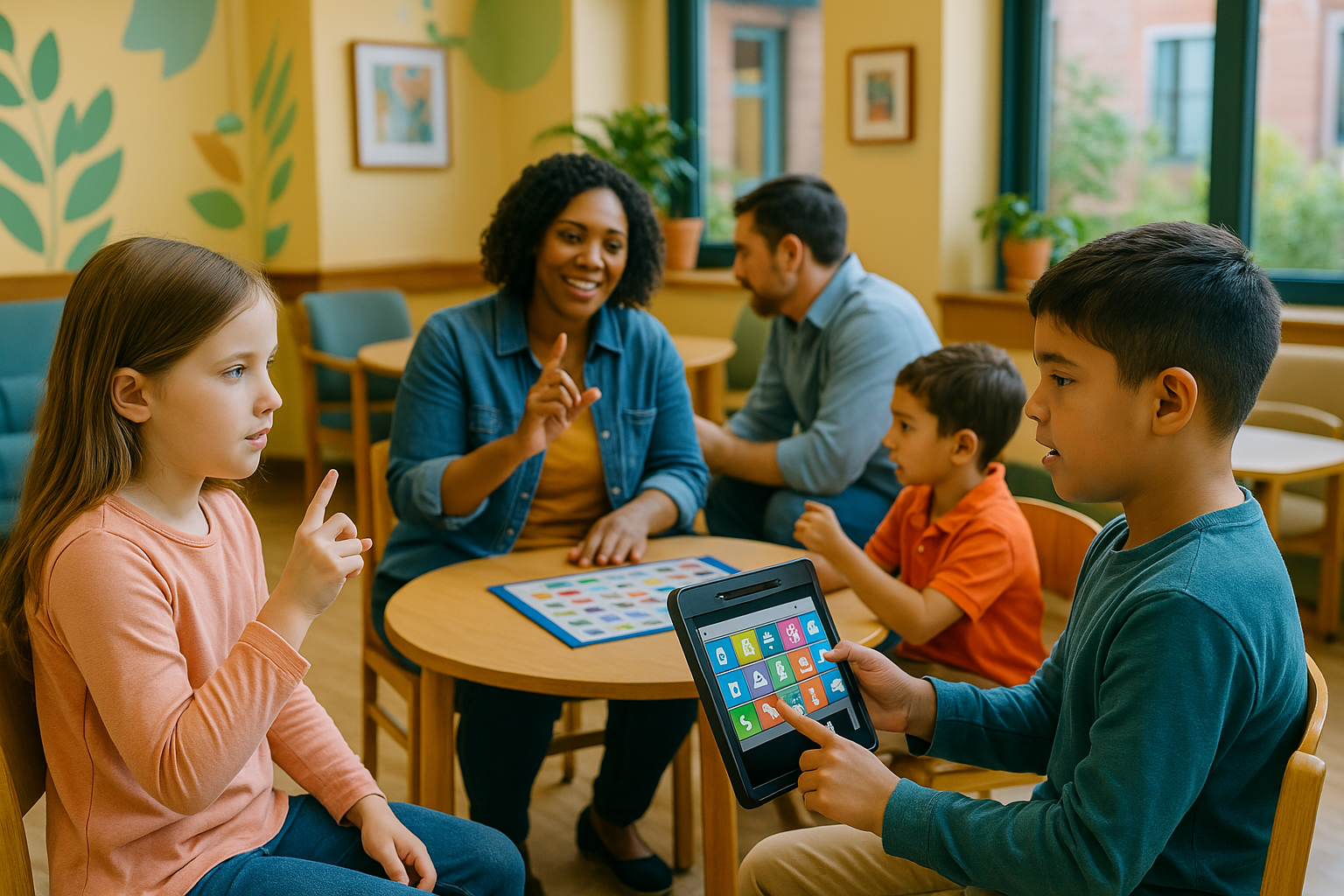💬 Communication Challenges
Why is speech difficult?
Children affected by LMBRD2 gene mutation may present:
✅ Severe delay or complete absence of speech
✅ Language comprehension often more developed than their ability to express themselves
✅ Difficulties articulating or coordinating the mouth movements necessary for speech
✅ Oral-facial apraxia (difficulty planning and executing mouth movements)
✅ Increased frustration due to their inability to express their needs and emotions
🧠 What parents should know
Research shows that even in the absence of verbal language, children often understand much more than they can express. Here are some important points to remember:
- Cognitive development can progress normally despite the absence of speech
- Intelligence is not necessarily affected by language difficulties
- Each child has unique potential that can be expressed through alternative pathways
- Non-verbal communication is a form of communication in its own right
- Early introduction of alternative communication tools can reduce frustration and behavioral issues
🛠️ Alternative Communication Solutions
The solutions below do not replace the acquisition of oral language, but they allow children to express their needs, learn to structure their thoughts, and interact with others. The goal is to give your child a voice, whatever form it takes.
1️⃣ MAKATON: A Multi-Modal Communication System
Makaton is a communication method that combines:
- Signs inspired by sign language
- Simple visual symbols to represent words
- Oral language that systematically accompanies signs and images
✅ Why is Makaton useful?
- Allows children to associate a gesture or image with a word
- Facilitates understanding and vocabulary learning
- Uses multiple sensory channels (visual, auditory, kinesthetic)
- Helps reduce frustration by providing an immediate means of expression
- Can be used from a very young age
📚 How to get started with Makaton?
- Start by learning 5-10 signs corresponding to your child’s essential needs (eat, drink, sleep, hug, play)
- Systematically use these signs in your daily communication
- Display the corresponding symbols around the house (for example, the “eat” symbol on the table)
- Encourage the whole family and close ones to use these signs
- Praise each communication attempt, even imperfect ones
📌 The challenge:
Makaton requires involvement from parents, teachers, and relatives because, to be effective, it must be used daily in different contexts. It is recommended that parents receive training.
🔍 Comparison of popular applications & websites
- The Makaton Charity (UK): https://makaton.org/ – Offers training, resources, and materials in English
- AAD Makaton (France): https://www.makaton.fr/ – The official French association for Makaton
- MyChoicePad: https://www.mychoicepad.com/ App containing over 4000 Makaton signs and symbols
💡 Parent testimonial
“Audrey about Jules: At first, we were skeptical about the usefulness of signs. But after a few weeks of consistent use, our son started reproducing the ‘more’ sign during meals. It was his first intentional way of communicating with us!”
🔗 Resources:
- Makaton associations in several countries
- Training for parents and professionals
- Adapted applications and books
2️⃣ PECS (Picture Exchange Communication System): Communication through Images
PECS is a structured method of communication through image exchange. The child learns to give an image to get what they want, then gradually to build visual sentences.
✅ How does it work?
Phase 1: Physical exchange
- The child learns to give an image representing a highly desired object
- Two adults may be needed initially: a communication partner and a “physical prompter”
Phase 2: Developing spontaneity
- The child learns to go get their communication binder and find the desired image
- The distance between the child and the communication partner gradually increases
Phase 3: Image discrimination
- The child learns to choose between several images
- They develop the ability to recognize and differentiate symbols
Phase 4-6: Sentence construction and comments
- The child learns to structure sentences by combining multiple images (e.g., “I want” + “apple juice”)
- Gradually, they can learn to comment, answer questions, and expand their vocabulary
📋 How to create a PECS system at home?
- Materials needed:
- A ring binder with velcro strips
- Laminated images representing favorite objects/activities
- Adhesive velcro (soft side and rough side)
- A sentence strip for building statements
- Implementation steps:
- Identify 5-8 highly motivating items for your child
- Create clear, appropriately sized images (about 5×5 cm)
- Place these images on the cover or first page of the binder
- Establish a consistent usage routine
📌 The challenge:
Patience and consistency are essential: initially, the child must be physically guided to understand the connection between the image and the object. PECS implementation often requires support from a professional (speech therapist, special educator) for optimal setup.
🔍 Comparison of popular applications and websites
- Pyramid Educational Consultants: https://pecsusa.com/ (USA)
- https://pecs-france.fr/
- https://pecs-romania.com/
- PECS® IV+ App for the iPad® => https://www.pecs.com/PECSIV/
- Let me Talk app : https://apps.apple.com/us/app/letmetalk/id919990138
💡 Principle of PECS:
“The immediate obtainment of the requested object is essential. This immediacy reinforces the power of communication and motivates the child to continue using the system.”
🔗 Resources:
- Pyramid Educational Consultants
- Practical guides for parents
- Online and in-person training
3️⃣ AAC (Augmentative and Alternative Communication): Technologies and Applications
Augmentative and alternative communication (AAC) devices include tablet applications and voice synthesizers that allow children to select images, words, or phrases to express themselves.
✅ Why use AAC?
- Portability and social acceptance (using a tablet is discreet and empowering)
- Advanced customization (possibility to use real photos from the child’s environment)
- Scalability (from a few images to thousands of symbols organized by categories)
- Speech synthesis allowing the child to be heard by everyone
- Possibility to save and track communication progress
📱 Choosing the right AAC application
The choice of application depends on several factors:
- Child’s cognitive and motor level:
- Ability to point precisely
- Understanding of categories and navigation
- Visual and auditory capacity
- Important features:
- Vocabulary customization
- Ability to use real photos
- Word/phrase prediction
- Compatibility with different accessories (switches, eye-tracking)
- Possible progression:
- From simple to complex
- From image to text
- From pre-recorded phrases to free construction
📌 The challenge:
Learning an AAC system takes time and patience. Additionally, the cost of applications and equipment can be high, although funding solutions often exist through healthcare systems or associations.
🔍 Comparison of popular applications
- https://www.assistiveware.com/products/proloquo2go
- https://apps.apple.com/us/app/grid-for-ipad-aac/id1064332378
- https://letmetalk.en.aptoide.com/app
- https://us.tobiidynavox.com/pages/td-snap
- https://avazapp.com/products/avaz-aac-app/
4️⃣ Multimodal Communication – The hybrid approach
Many specialists now recommend an approach combining several communication methods, adapted to each child’s strengths and preferences.
✅ Why a multimodal approach?
🔹 Each child has different preferences and abilities (some are more visual, others more gestural) 🔹 Different contexts may require different tools (a tablet is not practical at the swimming pool!) 🔹 Redundancy between systems reinforces learning 🔹 The child can choose their preferred mode of expression depending on the situation
📊 Example of a multimodal approach
- At home: Combination of Makaton signs and PECS boards on walls
- At school: Use of an AAC application on a tablet with the same vocabulary
- On the go: Mini portable PECS binder and basic signs
- For extended family: Simple visual cards with corresponding signs
💡 Expert advice
“Don’t worry about ‘confusing’ your child by using multiple systems. Research shows that children can generally navigate between different modes of communication without difficulty. The important thing is consistency in the vocabulary used.”
👨👩👧👦 The Central Role of the Family
🏠 Creating an environment conducive to communication
- Visually structure the living space:
- Label everyday objects with images
- Create activity boards for routines (morning, meals, bedtime)
- Install communication boards in each room
- Involve all family members:
- Organize family “sign workshops”
- Create a “word/sign of the week” that everyone learns
- Value siblings as “communication experts”
- Adapt your own communication:
- Speak more slowly and with simple sentences
- Systematically accompany your words with signs/images
- Give the child time to respond (count to 10 mentally)
- Interpret and verbalize communication attempts
💪 Facing emotional challenges
The absence of verbal communication is often a source of concern and grief for parents. Here are some tips:
- Accept your emotions as normal and legitimate
- Join support groups for parents of children with LMBRD2
- Celebrate each small progress, whatever its form
- Document advances (journal, photos, videos) to see evolution
- Take care of yourself – your well-being is essential
👩⚕️ The Importance of Medical and Paramedical Monitoring
Whatever communication mode is chosen, support from professionals is essential to help the child progress:
✅ Ideal multidisciplinary team
- Speech therapists: Communication disorder specialists who assess abilities and adapt strategies according to the child’s profile How to work with them: Ask for exercises to do at home, share your observations, set realistic goals together
- Occupational therapists: Help manipulate communication tools and adapt the environment to promote autonomy How to work with them: Discuss specific motor difficulties, ask for adaptations for home and school
- Psychomotor therapists: Work on coordination, gross motor skills, and sensory integration How to work with them: Share your child’s sensory preferences, ask for adapted sensorimotor activities
- Psychologists: Support the child and family on the emotional and social aspects of communication How to work with them: Don’t hesitate to share your own difficulties and concerns
- Genetic doctors: Provide medical follow-up specific to the LMBRD2 mutation How to work with them: Keep a detailed health record, note all changes, even minor ones
🏫 Coordination with the school environment
School is an essential place for socialization and learning. To promote inclusion:
- Liaison document:
- Create a simple document explaining the communication system used
- Include photos/concrete examples
- Offer a short training session for teachers and teaching assistants
- Adapted material:
- Provide a duplicate of the communication system for school
- Offer visual supports for school activities
- Ensure that the material is permanently accessible
- Regular monitoring:
- Organize quarterly meetings with the educational team
- Use a daily communication notebook
- Share progress observed at home
🌱 Evolution Perspectives and Hope
Developmental trajectories
Each child with an LMBRD2 mutation follows their own path, but certain trends can be observed:
- Some children develop limited but functional verbal language after several years of intervention
- Others thrive with permanent alternative communication
- Most make significant progress in their overall communication abilities
- Progress often continues well beyond childhood, into adolescence and adulthood
🔬 Research and innovations
Research is advancing rapidly in several areas:
- Genetics: Better understanding of mechanisms related to LMBRD2
- Adaptive technologies: Development of brain-computer interfaces, more intuitive applications
- Targeted therapies: Specific approaches for communication disorders related to genetic mutations
💙 Inspiring testimonial
“Antonio about Jules: Our son received his LMBRD2 diagnosis at age 4. At 4, he wasn’t speaking and our communication was very limited. Today, at 7, he uses a combination of signs, and a few words. The journey has been long, but his radiant personality can now be more and more expressed.”
💡 Conclusion
Communication is a fundamental right for every child. Even in the absence of oral language, tools like Makaton, PECS, and AAC devices allow them to have a voice and break isolation.
For parents, the path can be difficult, but it is possible to provide the child with ways to express their emotions, needs, and desires. With patience, professional support, and a nurturing environment, significant progress is possible.



